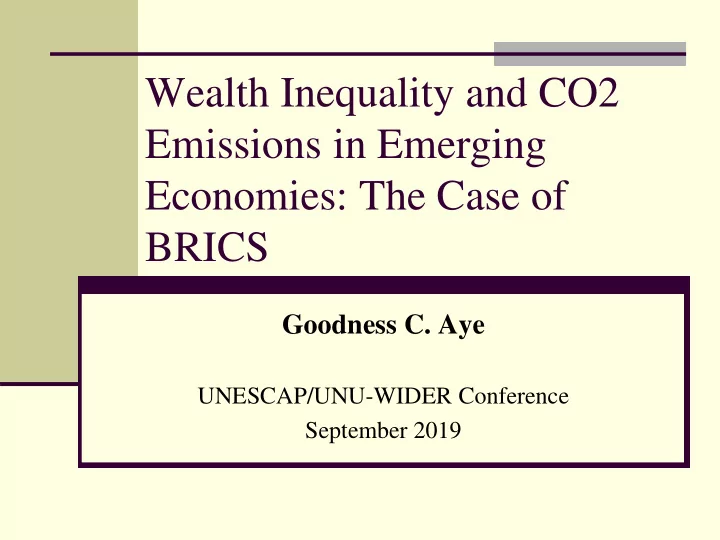

Wealth Inequality and CO2 Emissions in Emerging Economies: The Case of BRICS Goodness C. Aye UNESCAP/UNU-WIDER Conference September 2019
Outline ❖ Introduction/Literature review ❖ Methodology ❖ Results ❖ Conclusion
Introduction ❖ Inequality & climate change prominent in policy & research arena ❖ SDG goal #10 reducing inequality within & among countries by 2030 ❖ Rising trend in equality ❖ Many countries unequal: income & wealth inequality ❖ E.g SA: Income Gini is 0.63 (World Bank, 2018) ❖ Wealth Gini is 0.84 (Shorrocks et al., 2015)
Introduction ❖ The level & trend of equality should be of a policy priority. ❖ Inequality has consequences on the economy. ❖ Recent debate: inequality is partly responsible for the increasing greenhouse gas emissions ❖ Richest 10% contribute about 50% of the world’s global carbon emission ❖ While the poorest 50% contribute only 10% (Oxfam International, 2015).
Introduction ❖ Theoretical channels: ➢ Labour & consumption dynamics- Marginal propensity to emit approach (Ravallion et al., 2000; Zhang and Zhao, 2014; Jorgenson et al., 2017; Knight et al., 2017). ➢ Veblen effect (Veblen 1934; Bowles and Park, 2005; Fitzgerald et al., 2015; Knight et al., 2013). ➢ Political economy approach (Boyce,1994; Boyce, 2007; Downey, 2015; Cushing et al. 2015; Knight et al., 2017).
Introduction ❖ Empirical studies on effect of inequality on CO2 emission (Ravallion et al., 2000; Jorgenson et al., 2015; Jorgenson et al., 2016; Jorgenson et al., 2017; Knight et al., 2017). ❖ All except Knight et al. (2017) focused on income inequality. ❖ Knight et al. (2017) analysed HICs ❖ Objective: examine the role of wealth inequality on CO2 emission in BRICS.
Methodology ❖ A balanced panel dataset of annual observations from 2000 to 2014 ❖ CO2 emissions per capita (WDI). ❖ Wealth inequality-top decile of adults age >20 (Shorrocks et al., 2014). ❖ Control variables: GDP per capita, population & domestic credit to the private sector (WDI). ❖ Log transformation ❖ Both fixed and random effects panel models estimated
Methodology ❖ The fixed effects model: 𝑍 𝑗𝑢 = 𝛾𝑌 𝑗𝑢 + 𝜒 1 𝑎 𝑗𝑢 +...+ 𝜒 𝑙 𝑎 𝑗𝑢 + 𝛽 𝑗 + 𝑣 𝑗𝑢 (1) ❖ The random effects model: 𝑍 𝑗𝑢 = 𝛾𝑌 𝑗𝑢 + 𝜒 1 𝑎 𝑗𝑢 +...+ 𝜒 𝑙 𝑎 𝑗𝑢 + 𝛽 + 𝑣 𝑗𝑢 + 𝜁 𝑗𝑢 (2)
Results ❖ Table 1: Descriptive statistics of variables in log form CO2 TOP10 GDP POP FD Mean 1.427 4.229 10.548 19.491 4.123 Median 1.674 4.250 10.707 19.068 3.949 Maximum 2.548 4.440 13.329 21.034 5.076 Minimum -0.033 3.884 7.480 17.638 2.613 Std. Dev. 0.881 0.121 1.654 1.275 0.669 Skewness -0.241 -1.236 0.051 0.019 -0.111 Kurtosis 1.476 4.186 2.343 1.479 1.821 Jarque-Bera 7.986 23.497 1.382 7.231 4.501 Probability 0.018 0.000 0.501 0.027 0.105
Results ❖ Table 2: Estimates of fixed and random effects models (1) (2) VARIABLES Fixed Effects Random Effects Top10 0.8526** -5.9417*** (0.0120) (0.0000) GDP 0.6621*** 0.6035*** (0.0000) (0.0000) Population 0.4882** -0.2819*** (0.0249) (0.0000) Financial Development -0.1590*** 0.5886*** (0.0001) (0.0000) Constant -18.0224*** 23.2550*** (0.0000) (0.0000) Observations 75 75 R-squared 0.9169 0.6460 F-Stat/Wald Chi2 182.03*** 127.72*** (0.000) (0.000) Number of id 5 5 Individual FE YES YES Hausman test 69.18 (0.000)
Conclusion ❖ Examined the relationship between wealth inequality and CO2 emissions for the BRICS ❖ Wealth inequality, GDP per capita and population have positive effect on CO2 emissions ❖ The concentration of income among the top of the distribution leads to environmental degradation ❖ Financial development has a negative effect. ❖ The need for pro-poor, inclusive economic growth and low carbon development policies is supported by these findings.
Conclusion ❖ Policies that combine equality-enhancing effects with direct reductions in emissions could be helpful. ❖ Perhaps the use of wealth tax, trading emission permits alongside with carbon tax among others may be promising. ❖ Environmental safety, efficiency and improvements + social policies cannot be overstressed
Thank you
Recommend
More recommend